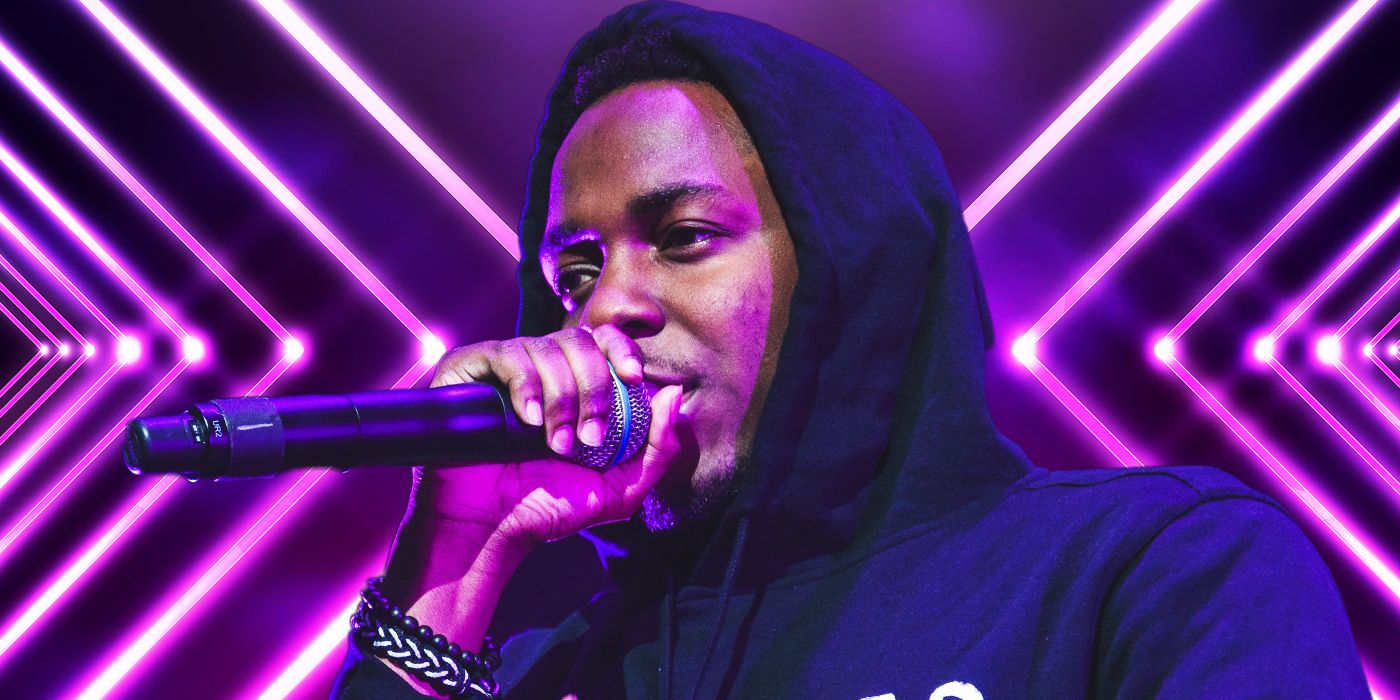10 Best Kendrick Lamar Songs, Ranked


11
Kendrick Lamar has been dominating mainstream rap for well over a decade. Before the Compton rapper’s now-famous diss track Not Like Us became the biggest cultural touchpoint of 2024, he was already shaping the industry and earning his place as one of the best to ever do it.
Part of Lamar’s appeal as an artist is the narrative focus he brings to his work. Most of Lamar’s studio albums have functioned as complete pieces of work that tell a story throughout. These narratives are engaging, layered and complex, but that doesn’t preclude Lamar’s singles from standing on their own two feet. Many of his tracks are catchy, engaging and manage to tell both a contained story within the song and form part of the larger story of the record they appear on. It isn’t easy to narrow it down, but here are the ten best songs from Kendrick Lamar.
10
“Swimming Pools (Drank)” (2012)
‘good kid, m.A.A.d city’
What sounds like a boppy dance track is actually a deeper exploration of peer pressure and role modeling of alcohol abuse. The key metaphor throughout “Swimming Pools (Drank)” isn’t necessarily subtle, but it is effective and accessible as a listener. References to daily “backstroke,” Baywatch and pools of alcohol draw a strong connection to Lamar’s early life and the prevalence of alcohol abuse around him.
In addition to seeing role models and adults around him “drowning” in their alcohol use, Lamar also explicitly outlines the peer pressure he faced to keep pace with the drinking around him. “Swimming Pools (Drank)” is so emblematic of Lamar’s music more broadly, and also his appeal as an artist. For Lamar, a great beat and enjoyable listening experience don’t have to be mutually exclusive with earnest and personal content about dark topics that clearly connect with him as an artist.
9
“Money Trees” (2012)
‘good kid, m.A.A.d city’
The narrative explored throughout good kid, m.A.A.d city continues on “Money Trees.” The 2012 record explores Lamar’s youthful experience in retrospect and in earnest. “Money Trees” unpacks the pull between “easy money” and more ethical behavior. Lamar acknowledges that his choices in life, good and bad, have shaped the artist he is now. “Money Trees” gets into the nitty-gritty details of what some of these choices actually entail.
Lamar discusses how tempting it is to rob houses for easy money and sleep with women who are interested in him. But he also discusses the potential downsides of risky sex and engaging in a life of violence. The message of the track is summed up perfectly in its catchy and succinct chorus, where Lamar states you can “pick your poison” and choose “Halle Berry or hallelujah.” As an artist, Lamar’s openness to embrace ambiguity and the power of one’s own choices are essential elements of his voice and persona.
8
“King Kunta” (2015)
‘To Pimp a Butterfly’
From just the song’s title, it’s clear to see the dichotomy that Lamar is exploring throughout “King Kunta.” The title is a reference to Kunta Kinte (LeVar Burton) in the miniseries Roots (based on Roots: The Saga of an American Family by Alex Haley). In Roots, Kunta Kinte is enslaved in the United States and refuses to take on a slave name, even in the face of great personal suffering and torture. Despite being at the bottom of the social hierarchy, Kunta’s strength and resilience elevate him as a moral leader and a symbol to his peers.
His strength to stay true to himself as a Black man make him a king. This message is so essential to Lamar’s journey as an artist. The notion of “just being yourself” is typically uncomplicated and trite. But, for minority groups and Black Americans, succeeding while being true to yourself, your history and your culture is a privilege not many are afforded. Perhaps the best thing about “King Kunta” as a track is that it has this aforementioned narrative richness, which weaves in historical context and Lamar’s personal experience. But, at the same time, it’s an infectious and addictive banger that is one of Lamar’s most crowd-pleasing tracks.
7
“m.A.A.d City” (2012)
‘good kid, m.A.A.d city’
Divided into two distinct parts, “m.A.A.d City” is another piece of the good kid, m.A.A.d city story. Over the course of the 2012 record, Lamar reflects on his early life through the eyes of his younger self. The first half of the song is a hard and bass-laden exploration of gang activity on the streets of Compton, and the real stories of things Lamar saw as a youth.
The second half of the song is equally as challenging in terms of its content. But, rather than just laying out the surrounding violence, Lamar adds a layer of introspection to the narrative. He explores the pull between the life his dad wants for him and the allure of the gang lifestyle he’s exposed to every day. While it’s clear from his lyrics that he isn’t proud of all of his choices, the ultimate takeaway from “m.A.A.d City” is that these experiences shaped him, and now enable him to do better for himself and his community.
6
“i” (2014)
Single version
After being released as a single, an alternate version of “i” was released on To Pimp a Butterfly. While both versions have their merits, the single version from 2014 is so infectiously positive that it’s impossible to ignore. Like much of Lamar’s work, “i” explores the consequences of violence and the darker sides of life. But unlike many of his other tracks, “i” also showcases Lamar’s desire to love himself and his community despite the darkness.
The upbeat electric guitar and retro feel are thanks to the sample at the heart of the track: “That Lady” by The Isley Brothers. The funky 70’s melody equals the positivity of Lamar’s confident and optimistic lyrics. Rap is often defined by struggle and conflict, and while that is a part of it for some rappers, such stereotypes can result in artists being pigeonholed. As a result, it can feel as though rappers looking to succeed must leverage their own trauma and suffering on the world stage to gain credibility. While Lamar has been vulnerable and open about his personal turmoil, it’s refreshing to see an artist expressing joy and hopefulness so openly, and being rewarded for it (“i” won Best Rap Song and Best Rap Performance at the 2015 Grammys).
5
“Untitled 02 | 06.23.2014” (2016)
‘Untitled Unmastered’
The ominous and fatalist perspective of Untitled Unmastered is unpacked in “Untitled 02 | 06.23.2014.” The moody track explores the contrast between where Lamar and his peers started compared to where they are now. The idea of ‘survivor’s guilt’ is present throughout a lot of Lamar’s work, and the rapper frequently wrestles with the contrast between the success that enabled him to leave Compton and the love and loyalty he still has toward the city that made him who he is.
“Untitled 02 | 06.23.2014” is one of the more interesting examples of this ongoing dialogue Lamar has with himself and his listeners. While Lamar always has a perspective, he’s also comfortable exploring themes and feelings that don’t have a tidy resolution. Lamar will never let go of his connection to his community, but his fame and success inarguably distance him from the modern experiences of the same community. This provides the painful but relatable see-saw upon which many of Lamar’s lyrics teeter. Lamar may never be entirely comfortable with the gulf between where he started and where he is now, but hearing him explore these topics is as cathartic for listeners as it likely is to Lamar himself.
4
“These Walls” (2015)
‘To Pimp a Butterfly’
Lamar’s These Walls uses the common idiom “if these walls could talk” as a vehicle to discuss intimate topics and private thoughts through layers of innuendo and metaphor. The “walls” he mentions are a thinly veiled reference to certain female anatomy, as well as the walls of one’s own mind. The narrative throughout the track revolves around Lamar being intimate with a woman whose boyfriend is in jail (a continuation of the “walls” metaphor).
Lamar gets into detail about how enjoyable it is to be intimate with the woman he’s rapping about, but says he also feels conflicted about whether using his clout to seduce someone for his own benefit is ethical. As usual, this ethical dilemma and masterful use of metaphor and innuendo are supported by a rhythmic beat and overtones of funk and soul. The track cuts a striking contrast against u, which is the next song on To Pimp a Butterfly. The songs almost feel like two sides of the same coin. Both explore being conflicted within relationships with others, but while u is moody and aggressive, These Walls is warm and endearing in its melody and message.
3
”Not Like Us” (2024)
Single
Many diss tracks have gone on to become iconic singles in their own right. From “Hit ‘Em Up” to “No Vaseline,” rap lovers have often reaped the rewards of artist quarrels. But, even the most iconic disses have never come close to achieving the mainstream dominance and cultural impact of “Not Like Us”. Lamar’s scathing diss track is witty, artfully written and utterly devastating for one man in particular: Drake.
The mainstream appeal of the two artists combined with how quickly gossip spreads online contributed to the gargantuan cultural impact of the track. These factors meant that listeners already had a good idea of Drake’s dirty laundry before Lamar put the final nail in the coffin by airing it out. The coup de grâce of the very public beef was when Lamar performed “Not Like Us” at the 2024 Super Bowl halftime show and the crowd of 70,000 sung along to the song’s most memorable line. “Not Like Us” exposes some very obvious gripes that Lamar has with Canadian rapper Drake, but there’s much more to it than a few salacious accusations. At the core of the track (and its title) is the notion that Kendrick and Drake are so starkly different, that they don’t compare. This is embodied in the lyric “you not a colleague, you a f***n’ colonizer”, which succinctly lays out Lamar’s thesis statement: Drake is profiting from a culture that he isn’t a part of, which is defined by more than just skin color.
2
”Backseat Freestyle” (2012)
‘good kid, m.A.A.d city’
For millennial rap lovers, there are few hooks that are as iconic as that of “Backseat Freestyle.” Prior to good kid, m.A.A.d city, Lamar had released a slew of mixtapes under his K.Dot persona and one studio album as Kendrick Lamar. His prior work had gained him industry recognition and a record deal with Top Dawg Entertainment. But, good kid, m.A.A.d city would launch the Compton rapper into the mainstream.
“Backseat Freestyle” is bass-driven, youthful and confident. The track’s composition and vocal variety epitomize the celebration of success and excess that the song is about. Like other tracks on good kid m.A.A.d city, “Backseat Freestyle” is performed from the specific perspective of a younger Lamar. The over-the-top bravado is intentionally absurd. Much like “Fight For Your Right” by The Beastie Boys, “Backseat Freestyle” succeeds at taking a cheeky dig at party anthems while also being a party anthem.
1
“u” (2015)
‘To Pimp a Butterfly’
The frenetic jazz influence that courses through To Pimp a Butterfly is at its most potent in “u.” What is also profoundly potent is Lamar’s raw honesty and vulnerability. This vulnerability is exhibited in the words themselves, and also the varied and theatrical vocal performance. Rap has always been likened to poetry, and u is a perfect example of the commonalities between a rapper and a spoken-word poet.
Lamar mixes the melody with an immersive soundscape that depicts a man in a drunken spiral. While spiraling, his inner-dialogue is dominated by hate for others and for himself. Despite the thematic heaviness of the content in “u,” the frantic melody, which feels simultaneously fast and slow, is hypnotic. This cocktail of factors result in a poignant and artful track that is as enjoyable to listen to as it is confronting.





